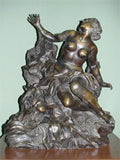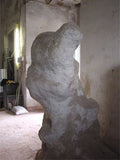Lead
The production of lead sculpture reached its height in England during the 18th century. Most was cast in one piece, and sand or plaster used as a core material. The iron armature was left inside sculptures to provide support.
The original iron armature will inevitably corrode and, as it does so, the rust expands to up to ten times the volume of the original iron. So lead sculpture is particularly vulnerable to splitting and collapse as the armature is weakened. Lead itself is generally resistant to corrosion and, if unpainted, the surface will develop a protective natural patina. As a soft material, impact damage is commonly found on lead sculpture in the form of superficial dents and scratches to the surface and as such it is very vulnerable to vandalism.
The conservation of lead sculpture often necessitates removal of the original armature and core material followed by the insertion of a new stainless steel armature. This may require cutting patches and sections to allow access (take a look at our example pages for more details). This process restores the structural integrity of the piece and if performed by experienced conservators, the sculpture will retain the appropriate, aged appearance and will be structurally stable.
We actively promote good practice in the care of lead sculpture, and to this end we have produced additional information pages which we hope may be helpful to those responsible for the care of lead sculpture, to students and to practitioners. These are:
Common forms of damage on lead sculpture
Poor techniques to be avoided when conserving lead sculpture









